Linear format equations using UnicodeMath and LaTeX in Word
You can also create math equations using on the keyboard using a combination of keywords and math autocorrect codes. New to Word for Office 365 subscribers is the ability to type math using the LaTeX syntax; details described below.
- Unicode math
- LaTeX math
Depending on your preferred input format, you can create equations in Word in either one of UnicodeMath or LaTeX formats by selecting the format from the Equations tab.

Note: All the other Office applications support only UnicodeMath linear format.
- Enter your equation using Alt + = on the keyboard.
- Choose Convert and select professional to build your typed fractions to their Professional form into subscripts, or use Ctrl + =. You can similarly convert an equation back down to a linear format with Ctrl + Shift + =.
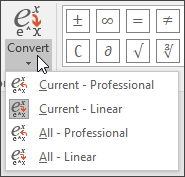
Examples
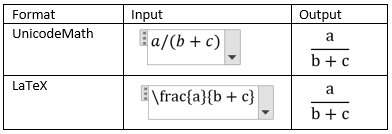
Note: Convert a professional format equation format to it’s source format, change the convert tool to build a linear format by selecting the desired option from the Convert menu.
You can type most equations in UnicodeMath quickly by using Math AutoCorrect codes. For example, to align an equation array, you can use @ and &, as in the following:
\eqarray(x+1&=2@1+2+3+y&=z@3/x&=6)<space>
which resolves to:
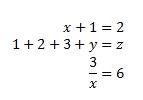
Here are some other examples:
| UnicodeMath format | Built-up format | |
|---|---|---|
| Vectors | (abc)\vec<space><space> |  |
| (abc)\hat<space><space> |  |
|
| Boxed formula | \rect(a/b)<space> |  |
| Brackets | (a+b/c)<space> |  |
| {a+b/c}<space> |  |
|
| Brackets with separators | {a/b\vbar<space>x+y\vbar<space>}<space> |  |
| Fractions | a/(b+c)<space> |  |
| LeftSubSup | _a^b<space>x<space> |  |
| Limit | lim_(n->\infty)<space>n |  |
| Matrix | (\matrix(a&b@&c&d))<space> |  |
| Nary | \iint_(a=0)^\infty<space><space>a |  |
| Over/Underbar | \overbar(abc)<space> |  |
| \overbrace(a+b)<space> |  |
|
| Radicals | \sqrt(5&a^2)<space> |  |
Note: When an example is followed by two consecutive spaces, the first space resolves the typed text into the equation, and the second space builds it up.
Microsoft Office uses the linear format described in Unicode Technical Note 28 to build up and display mathematical expressions. For more information, including how to quickly type up and build equations, see Unicode Nearly Plain-Text Encoding of Mathematics.
A=\{\matrix{a&b&c\\d&e&f\\g&h&j}\}
This will build into the following professional equation:

Here are some other examples of LaTeX expressions that can be built-up into a professional format.

Most LaTeX expressions are supported in this new feature to Word; a list of exceptions is provided below for LaTeX keywords that are not currently supported.
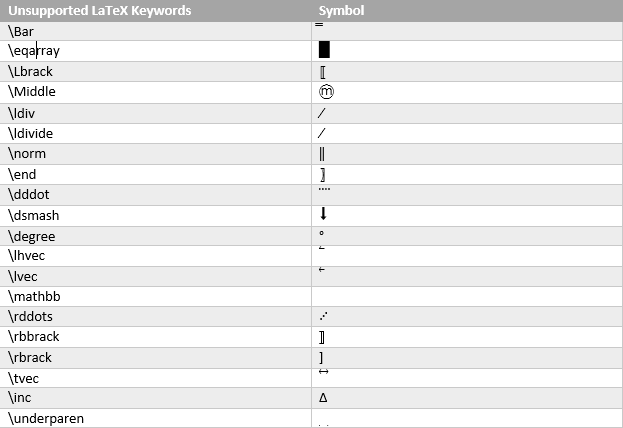 Some LaTeX expressions take a slightly different syntax than might be expected.
Some LaTeX expressions take a slightly different syntax than might be expected.For example, LaTeX matrices are often created using the following syntax:
\begin{matrix} a & b \\ c & d \end{matrix}
However \begin{} and \end{} keywords are not supported in Word, so instead, a LaTeX matrix input takes simply \matrix{} and would look like:
\matrix{a & b \\ c & d}
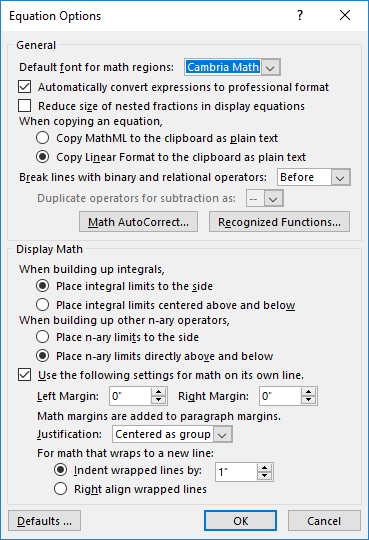
Type one of the following codes followed by a delimiting term. For example, after you type a code, type a punctuation mark, or press SPACEBAR or ENTER.
To ensure that the Math AutoCorrect symbols appear the same in your document as they do in the AutoCorrect dialog box, on the Home tab, in the Font group, select Cambria Math.
Important: The codes are case-sensitive.
| To get | Type |
|---|---|
 |
… |
 |
\above |
 |
\aleph |
 |
\alpha |
 |
\Alpha |
 |
\amalg |
 |
\angle |
 |
\approx |
 |
\asmash |
 |
\ast |
 |
\asymp |
 |
\atop |
 |
\bar |
 |
\Bar |
 |
\begin |
 |
\below |
 |
\bet |
 |
\beta |
 |
\Beta |
 |
\bot |
 |
\bowtie |
 |
\box |
 |
\bra |
 |
\breve |
 |
\bullet |
 |
\cap |
 |
\cbrt |
 |
\cdot |
 |
\cdots |
 |
\check |
 |
\chi |
 |
\Chi |
 |
\circ |
 |
\close |
 |
\clubsuit |
 |
\coint |
 |
\cong |
 |
\cup |
 |
\dalet |
 |
\dashv |
 |
\dd |
 |
\Dd |
 |
\ddddot |
 |
\dddot |
 |
\ddot |
 |
\ddots |
 |
\degree |
 |
\delta |
 |
\Delta |
 |
\diamond |
 |
\diamondsuit |
 |
\div |
 |
\dot |
 |
\doteq |
 |
\dots |
 |
\downarrow |
 |
\Downarrow |
 |
\dsmash |
 |
\ee |
 |
\ell |
 |
\emptyset |
 |
\end |
 |
\epsilon |
 |
\Epsilon |
 |
\eqarray |
 |
\equiv |
 |
\eta |
 |
\Eta |
 |
\exists |
 |
\forall |
 |
\funcapply |
 |
\gamma |
 |
\Gamma |
 |
\ge |
 |
\geq |
 |
\gets |
 |
\gg |
 |
\gimel |
 |
\hat |
 |
\hbar |
 |
\heartsuit |
 |
\hookleftarrow |
 |
\hookrightarrow |
 |
\hphantom |
 |
\hvec |
 |
\ii |
 |
\iiint |
 |
\iint |
 |
\Im |
 |
\in |
 |
\inc |
 |
\infty |
 |
\int |
 |
\iota |
 |
\Iota |
 |
\jj |
 |
\kappa |
 |
\Kappa |
 |
\ket |
 |
\lambda |
 |
\Lambda |
 |
\langle |
 |
\lbrace |
 |
\lbrack |
 |
\lceil |
 |
\ldivide |
 |
\ldots |
 |
\le |
 |
\leftarrow |
 |
\Leftarrow |
 |
\leftharpoondown |
 |
\leftharpoonup |
 |
\leftrightarrow |
 |
\Leftrightarrow |
 |
\leq |
 |
\lfloor |
 |
\ll |
 |
\mapsto |
 |
\matrix |
 |
\mid |
 |
\models |
 |
\mp |
 |
\mu |
 |
\Mu |
 |
\nabla |
 |
\naryand |
 |
\ne |
 |
\nearrow |
 |
\neq |
 |
\ni |
 |
\norm |
 |
\nu |
 |
\Nu |
 |
\nwarrow |
 |
\o |
 |
\O |
 |
\odot |
 |
\oiiint |
 |
\oiint |
 |
\oint |
 |
\omega |
 |
\Omega |
 |
\ominus |
 |
\open |
 |
\oplus |
 |
\otimes |
 |
\over |
 |
\overbar |
 |
\overbrace |
 |
\overparen |
 |
\parallel |
 |
\partial |
 |
\phantom |
 |
\phi |
 |
\Phi |
 |
\pi |
 |
\Pi |
 |
\pm |
 |
\pppprime |
 |
\ppprime |
 |
\pprime |
 |
\prec |
 |
\preceq |
 |
\prime |
 |
\prod |
 |
\propto |
 |
\psi |
 |
\Psi |
 |
\qdrt |
 |
\quadratic |
 |
\rangle |
 |
\ratio |
 |
\rbrace |
 |
\rbrack |
 |
\rceil |
 |
\rddots |
 |
\Re |
 |
\rect |
 |
\rfloor |
 |
\rho |
 |
\Rho |
 |
\rightarrow |
 |
\Rightarrow |
 |
\rightharpoondown |
 |
\rightharpoonup |
 |
\sdivide |
 |
\searrow |
 |
\setminus |
 |
\sigma |
 |
\Sigma |
 |
\sim |
 |
\simeq |
 |
\slashedfrac |
 |
\smash |
 |
\spadesuit |
 |
\sqcap |
 |
\sqcup |
 |
\sqrt |
 |
\sqsubseteq |
 |
\sqsuperseteq |
 |
\star |
 |
\subset |
 |
\subseteq |
 |
\succ |
 |
\succeq |
 |
\sum |
 |
\superset |
 |
\superseteq |
 |
\swarrow |
 |
\tau |
 |
\Tau |
 |
\theta |
 |
\Theta |
 |
\times |
 |
\to |
 |
\top |
 |
\tvec |
 |
\ubar |
 |
\Ubar |
 |
\underbar |
 |
\underbrace |
 |
\underparen |
 |
\uparrow |
 |
\Uparrow |
 |
\updownarrow |
 |
\Updownarrow |
 |
\uplus |
 |
\upsilon |
 |
\Upsilon |
 |
\varepsilon |
 |
\varphi |
 |
\varpi |
 |
\varrho |
 |
\varsigma |
 |
\vartheta |
 |
\vbar |
 |
\vdash |
 |
\vdots |
 |
\vec |
 |
\vee |
 |
\vert |
 |
\Vert |
 |
\vphantom |
 |
\wedge |
 |
\wp |
 |
\wr |
 |
\xi |
 |
\Xi |
 |
\zeta |
 |
\Zeta |
| (space with zero width) | \zwsp |
 |
-+ |
 |
+- |
 |
<- |
 |
<= |
 |
-> |
 |
>= |
Note: For information on inserting a symbol that is not in the chart above, see Insert a check mark or other symbol.
- Click File > Options.(In Word 2007, click the Microsoft Office Button
 , and then click Word Options.)
, and then click Word Options.) - Click Proofing, and then click AutoCorrect Options.
- Click the Math AutoCorrect tab.
- Select the Use Math AutoCorrect rules outside of math regions check box.


